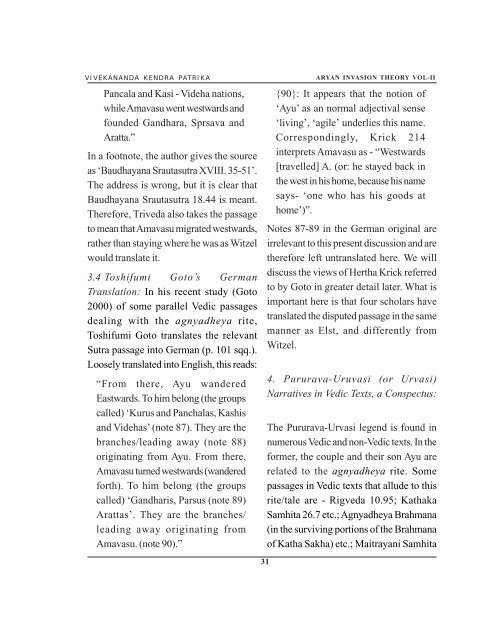Aryan Invasion Theory - Publication - Vivekananda Kendra
Aryan Invasion Theory - Publication - Vivekananda Kendra
Aryan Invasion Theory - Publication - Vivekananda Kendra
You also want an ePaper? Increase the reach of your titles
YUMPU automatically turns print PDFs into web optimized ePapers that Google loves.
VIVEKANANDA KENDRA PATRIKA ARYAN INVASION THEORY VOL-II<br />
Pancala and Kasi - Videha nations,<br />
while Amavasu went westwards and<br />
founded Gandhara, Sprsava and<br />
Aratta.”<br />
In a footnote, the author gives the source<br />
as ‘Baudhayana Srautasutra XVIII. 35-51’.<br />
The address is wrong, but it is clear that<br />
Baudhayana Srautasutra 18.44 is meant.<br />
Therefore, Triveda also takes the passage<br />
to mean that Amavasu migrated westwards,<br />
rather than staying where he was as Witzel<br />
would translate it.<br />
3.4 Toshifumi Goto’s German<br />
Translation: In his recent study (Goto<br />
2000) of some parallel Vedic passages<br />
dealing with the agnyadheya rite,<br />
Toshifumi Goto translates the relevant<br />
Sutra passage into German (p. 101 sqq.).<br />
Loosely translated into English, this reads:<br />
“From there, Ayu wandered<br />
Eastwards. To him belong (the groups<br />
called) ‘Kurus and Panchalas, Kashis<br />
and Videhas’ (note 87). They are the<br />
branches/leading away (note 88)<br />
originating from Ayu. From there,<br />
Amavasu turned westwards (wandered<br />
forth). To him belong (the groups<br />
called) ‘Gandharis, Parsus (note 89)<br />
Arattas’. They are the branches/<br />
leading away originating from<br />
Amavasu. (note 90).”<br />
31<br />
{90}: It appears that the notion of<br />
‘Ayu’ as an normal adjectival sense<br />
‘living’, ‘agile’ underlies this name.<br />
Correspondingly, Krick 214<br />
interprets Amavasu as - “Westwards<br />
[travelled] A. (or: he stayed back in<br />
the west in his home, because his name<br />
says- ‘one who has his goods at<br />
home’)”.<br />
Notes 87-89 in the German original are<br />
irrelevant to this present discussion and are<br />
therefore left untranslated here. We will<br />
discuss the views of Hertha Krick referred<br />
to by Goto in greater detail later. What is<br />
important here is that four scholars have<br />
translated the disputed passage in the same<br />
manner as Elst, and differently from<br />
Witzel.<br />
4. Pururava-Uruvasi (or Urvasi)<br />
Narratives in Vedic Texts, a Conspectus:<br />
The Pururava-Urvasi legend is found in<br />
numerous Vedic and non-Vedic texts. In the<br />
former, the couple and their son Ayu are<br />
related to the agnyadheya rite. Some<br />
passages in Vedic texts that allude to this<br />
rite/tale are - Rigveda 10.95; Kathaka<br />
Samhita 26.7 etc.; Agnyadheya Brahmana<br />
(in the surviving portions of the Brahmana<br />
of Katha Sakha) etc.; Maitrayani Samhita

















